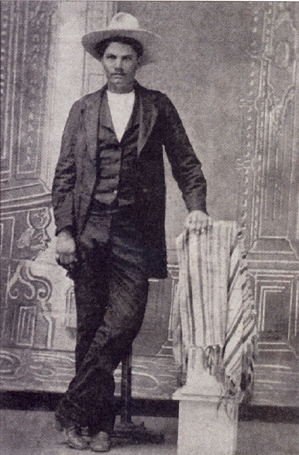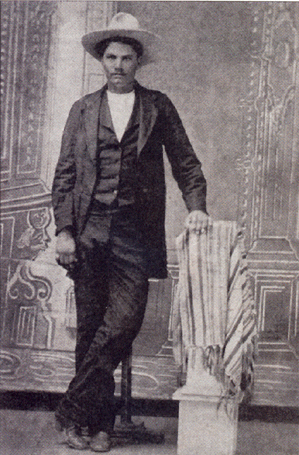(EDIT: I took down the video mid-2010. Look for the Gunfighters series on DVD)
 I am not a very good story writer since I tend to be very analytical in my writing. The gunfight has been covered a lot of times. I will list my favorite sources below for it. They explain it way better than I can. Let me just cover some of the issues not mentioned in the video.
I am not a very good story writer since I tend to be very analytical in my writing. The gunfight has been covered a lot of times. I will list my favorite sources below for it. They explain it way better than I can. Let me just cover some of the issues not mentioned in the video.One thing of importance that is rarely mentioned in popular stories about the gunfight is the issue of John’s brother, Joe Hardin. Joe came to the small town of Comanche in Texas in the early 1870’s. He had made a name for himself in the community and established himself in such a way that the rest of his extended family came to live there.
Many at the time did not realize, or at least did not come out publicly at the time, that Joe was doing illegal land deals for profit. By creating phoney documents he would “sale” land between different people. A typical deal might start with papers that were to show that land was owned by someone years earlier, then be sold to another person, then sold to another person, sold to a friend or relative of Joe, and back and forth. The paper trail would be such a confusing mess that if someone tried to verify the sources it would be too much trouble, and they would probably give up. Joe’s land scheme would come out much later. He not only did this with land, but with cattle as well.
Meanwhile, John Wesley Hardin had been preparing a herd of cattle for Kansas. Jim Taylor, a friend and ally in the Sutton-Taylor feud, decided to come along since he had just killed Bill Sutton a few months prior. It was a way he could stay out of trouble since he was being looked for in the Dewitt County area. Hardin had given the order to some of his men to take the herd north. He, Jim, and a few others would meet them on the way.
Hardin took off to Comanche to visit his dad, mom, and the rest of his family. A second herd was being worked out in Comanche. This was going to be the real problem and cause of the gunfight. This was a typical deal Joe Hardin had worked out with his phony paperwork. The disputed cattle were in nearby Brown County. Brown County cattlemen were already concerned and discussed the issue with the local law enforcement. It was decided that former Texas Ranger, and now deputy sheriff, Charles Webb would now be on the case.
The herd was in litigation, but John and his men forced the issue and took them. Webb, realizing that local cattle rustler’s Jim Buck Waldrip and James Beard were probably involved, arrested them. John, Joe Hardin, and the rest of their men ate dinner at the ranch of Jim Buck Waldrip. Mrs. Waldrip, complained over the Webb arrest. A crucial point was made later on in the trail against Hardin later that it was here a conspiracy was made to kill Webb. Joe Hardin was alleged to have something like, “When the time comes we will take care of him (Webb).”
On John’s 21st birthday there was a major celebration in the town. There was a festival, with the saloons running wild, and a race track going with horse races. John and his men did very well in the horse racing and won a lot of money. They spent the evening doing rounds at two saloons. It was at Jack Wright’s saloon that the local Sheriff Carnes and others like Jim Taylor were concerned about John because he had had too much to drink. Like most gunfighters, the more drink they had the better chances bad things would happen.
John could be very obnoxious when drunk. This would be another factor for what was about to go down. Charles Webb had been at the celebration. He was seen in the distance approaching the saloon.
John claims that he had never met Charles Webb before. If, and that is a big if, he had not met Webb before this confrontation, it does appear that he was probably pointed out to John during the celebration. There are some claims that John and his men had met Webb before and cursed him in Brown County.
In any case, Webb approached and John confronted him. He asked Webb if he had the papers to arrest him. Webb denied this. There was an exchange back and forth with John being verbally aggressive while Webb being rather soft and calm. A friend of Webb, seeing what was about to happen, called over to Webb since they were to eat dinner together. John held Webb and said something to the effect of, “Your not just going to leave me here are you?”
The next bit of dialogue has Webb saying that he was "not afraid" of John. It seems that some dialogue is missing in the accounts here because John said something accusing Webb of being a coward. At least that is what I get out of his response of not being afraid.
Within minutes a crowd of angry residents appear at near the saloon. John surrenders his gun to Sheriff John Carnes. Carnes attempts to protect John and company from the mob who want to hang them. John, along with his men, slip out the side door and take off.
This killing marked the end for John Wesley Hardin and his gang. In the following days a massive manhunt started with posses and Texas Rangers. Joe Hardin, Tom and Bud Dixon would be placed under arrest only to be hanged by a hooded mob. Two other cousins, Ham Anderson and Alexander Barekman were killed after they decided to leave John. Other members of his gang would eventually be lynched. A few years later, after leaving Texas for Florida, John was captured and sent to prison.
What is interesting to me is the aftermath of the gunfight. The town of Comanche was hysterical over what they thought John might do. There were rumors he would come back and burn the town to the ground over the hanging of Joe Hardin.
Mollie Godbold's two part article is my favorite reading of how this all went down. She really gives a good account of the fear of all the people involved.
Godbold, Mollie Moore. "Comanche and the Hardin Gang," Southwestern Historical Quarterly, June and July, 1963.
Alright, my last few blogs have been a bit lengthy, but, believe me, I really abbreviated a lot. I will go back to shorter location hunting blogs at the beginning of June. Until then...
